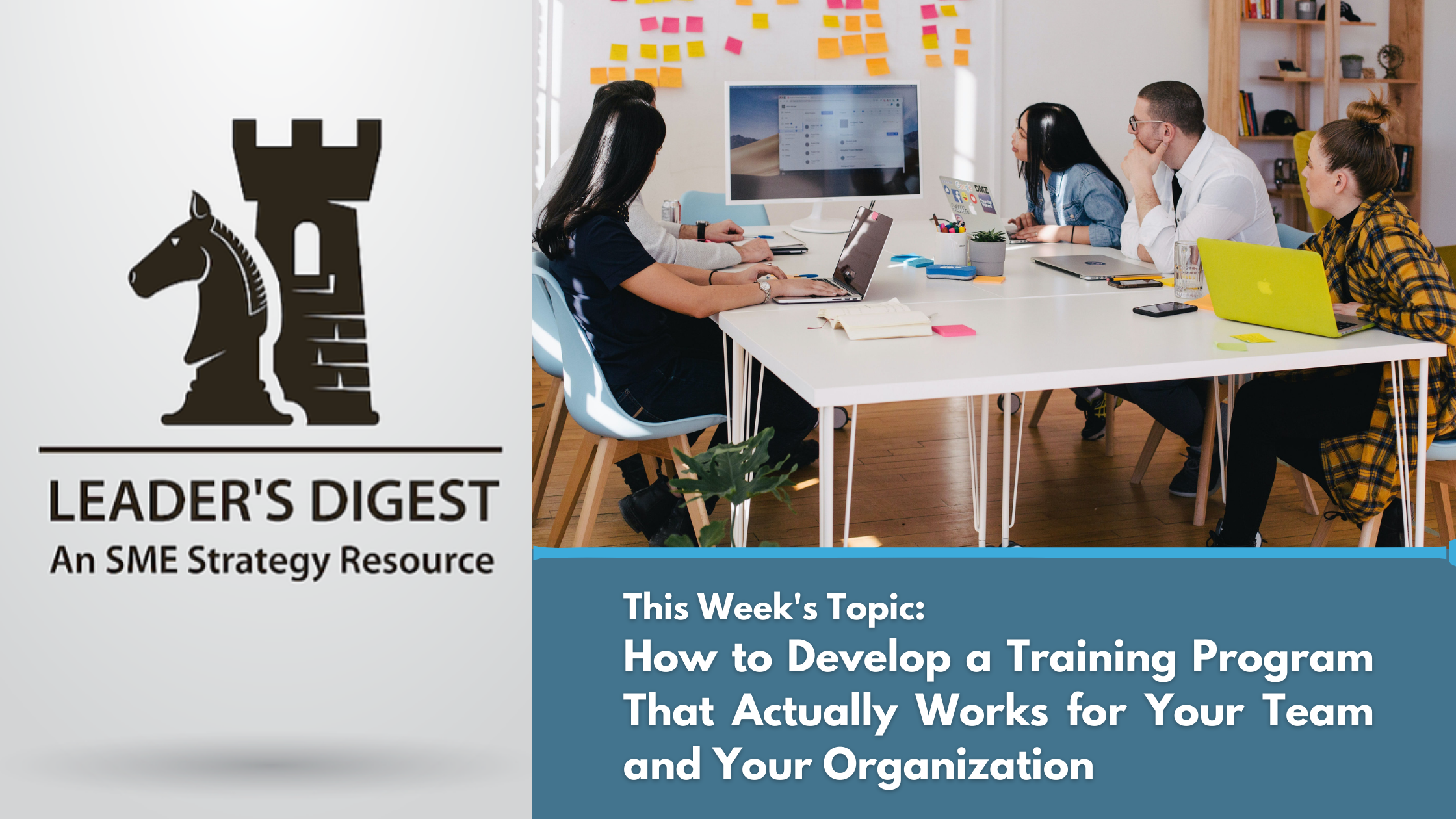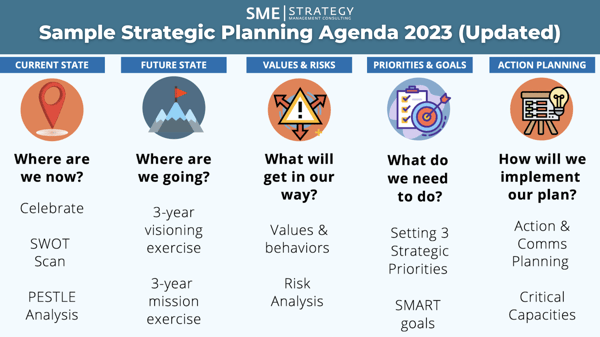How To Develop a Training Program That Works For Your Organization

Leader's Digest #15
Get our exclusive insights straight to your inbox! Subscribe now to Leader's Digest, our bi-weekly newsletter.
Are you currently engaged in management training at your organization, or planning to do so in the near future?
If so, you understand the vital role that training and development play in achieving organizational success. However, selecting the right program can be a complex and daunting task.
In 2023, effective training programs have become increasingly important due to the ever-changing landscape of the business world. As organizations confront challenges such as big data management, hiring and employee retention, new manager development, and a more diverse workforce than ever before, the need for proper training has never been greater.
Despite this, many organizations fail to align their training and development programs with their business needs. This often leads to a gap between leadership and front-line employees, resulting in employees perceiving training as a burden instead of a value-added component to their daily responsibilities. Consequently, employees often revert back to old habits and ways of doing things, leaving company performance stagnant.
To ensure that training and development programs are effective, it's crucial to ask the right questions. What format should the program follow? Do we do it In-house or get a strategy consultant? Should it be more than just academic? Is a workshop a better option than presentations? These are some of the questions that need to be answered to design a program that supports employees at the appropriate time.
Finally, it's important to recognize that management training is not a one-size-fits-all solution. Different teams have different needs, and the training program must be tailored to meet those needs. By doing so, your organization can create a cohesive story that engages employees and ensures that they feel valued and supported.
ANTHONY'S PERSPECTIVE
Hi, it's Anthony here. In this section of Leader's Digest, i'll Discuss How Misaligned Training and Development is Holding Your Organization Back (And 5 Ways to Fix It)
As a senior manager, you know that effective management training and development are crucial to building a stronger workforce. But, offering training sessions alone is not enough.
One of the biggest challenges companies face is finding time for training amidst busy schedules and pressing deadlines. That's why it's crucial to ensure that your training is not just a nice-to-have, but a must-have that contributes to you achieving your strategic goals. By providing training modules that support critical activities, you can maintain focus on essential tasks.
As a strategic planning facilitator, I have seen firsthand the importance of designing and implementing effective management training programs that align with your company's strategic plan. Unfortunately, many organizations invest heavily in training without considering how it supports their strategic goals or ties into their operations. According to a recent survey, only 25% of respondents believe that training measurably improved performance, despite U.S. training expenditures exceeding $100 billion in 2022. This misalignment can hinder organizational success and lead to wasted resources.
To avoid such pitfalls, it's crucial to align your management training programs with your company's strategic plan. Doing so will ensure that training and development programs genuinely help your employees develop the skills needed to achieve your organization's goals, rather than being a mere checkbox exercise.
In this video, I discuss the major problems that I see in companies when it comes to management training and offer five ways that you can address them to successfully incorporate management training that yields results.
As leaders, it's essential to ensure that the training and development programs are not just added skills, but relevant, timely, and applicable to the organization's needs. Here are five ways to ensure that your management training programs are aligned with your organizations strategic goals:
-
-
Align training with corporate objectives: To get the most out of your training programs, you must ensure they are aligned with your company's strategic plan. Having 20 different training modules is great, but not all modules will be relevant and effective at the same time. It's crucial to identify which training modules will have the most significant impact on the company's objectives and prioritize them.
-
Timeliness: It's essential to make sure that the training is timely and supports your organization in accomplishing its goals. While your training program may be excellent, if it's not applicable to the organization's current needs, it can be distracting. To avoid this, it's crucial to ensure that the focus remains on supporting the company's critical activities.
-
Application: The best training programs are those that are applicable and relevant to real-life situations. Ensure that your training modules are more of a workshop where participants can apply the concepts they have learned. This way, participants can use the skills and knowledge they have acquired in a real-life situation.
-
Use just-in-time learning: We want our employees to learn everything at once, but this is not realistic. Instead, it's better to use just-in-time learning, which is a partnership between the L&D team and functional leads. This partnership identifies the learning and development programs that can be applied immediately to support your organization in achieving its objectives.
-
Scaffolding Learning: To ensure your management training program is successfully executed, it's important to use a scaffolding approach that builds new concepts on top of existing ones. This promotes retention and development, making sure your middle managers are equipped to apply strategic thinking to their day-to-day work. At the core of this approach is teaching your managers how to use a model to better understand the strategic implications of their decisions and align them with corporate objectives. By breaking down complex concepts into smaller, more manageable pieces, your managers can develop a deeper understanding and make more informed decisions.
-
In conclusion, aligning your learning and development programs with your organization's strategic objectives is key to maximizing their impact. Investing in such programs is essential, but equally important is ensuring that they are relevant, timely, and applicable to your employees. By focusing on practical application, you can empower your Managers and their teams with training that directly supports their day-to-day work and contributes to achieving the organization's goals. In doing so, you can unlock the full potential of your workforce.
FURTHER INSIGHT
To develop a comprehensive understanding of what constitutes a good management training program and the various approaches taken by organizations of all kinds to train their management teams, we highly recommend reviewing the relevant articles.
-
Why Leadership Training Fails—and What to Do About It
Insight from HBR
Have you ever been sent to a leadership training workshop only to find that nothing seems to change when you get back to work? If so, you're not alone. The conventional approach to leadership training often fails because it focuses solely on improving individual skills without addressing the underlying systemic issues that prevent leaders from thriving. This article explores the reasons why leadership training often falls short and offers practical solutions for organizations to overcome these challenges.
-
Guide To Management Training Programs: Definition, Benefits and Common Topics
Insights From Leadership IQ
Management training programs have long been a popular way to enhance leadership skills and boost organizational effectiveness. However, this article delves deeper into what these programs entail, why they are important, how to get the most out of them, and explores the benefits that come with investing in these programs.
- The essential components of a successful L&D strategy
Insights from McKinsey
As a leader striving to enhance the performance and development of your team, crafting an effective learning and development (L&D) strategy is no easy feat. However, it's essential to remember that L&D is not just a box to tick, but a critical aspect of your organization's success. This article delves into the key components of a successful L&D strategy, highlighting the importance of aligning L&D with business goals, leveraging a variety of learning methods, incorporating feedback loops, and ensuring strong leadership support.
CONTRARIAN CORNER
In this segment of Leader's Digest, we highlight a new approach to dealing with the topic of discussion. This will identify alternative modern solutions for your consideration
Consider the following article, which presents a distinct viewpoint on the genuine impact of management training programs on employee performance.
Training Versus Performance (It isn't Always a Training Issue)
Do you ever find yourself frustrated with your team's lack of productivity, despite all the training they've received? It's easy to blame it on their lack of skills, but the truth is, training isn't always the answer. In fact, sometimes it can actually hinder performance. This article explores the real causes of workplace inefficiency and provides managers with practical solutions to increase productivity.
LIGHTS, CAMERA, ACTION!
Here are some actionable tips that you can use now to start the process of improving or creating your own management training program.
As a leader, it's important to take action to address any issues with your training program to ensure that your team is equipped with the skills they need to succeed. This article provides five actionable steps to help you fix a broken training program, including evaluating the current program, identifying the root cause of the problem, involving employees in the process, creating a tailored solution, and measuring the effectiveness of the new program.
-
How to Build Your First Employee Training Program
Insights from Workable
Are you looking to create your first employee training program? This article highlights the key components of an impactful employee training program, including identifying training needs, setting clear goals, designing engaging training materials, and measuring the effectiveness of your program. By the end of this article, you'll have a better understanding of how to create a successful employee training program that aligns with your business goals and supports your team's growth.
- Change management training: 6 things you need to know
Insights from Big Think
Change management is a crucial aspect of organizational success, particularly during times of significant transition. Whether it's implementing new systems, restructuring departments, or merging with another company, change management plays a vital role in ensuring a smooth transition and realizing the desired outcomes. This article explores how change management training can benefit organizations in numerous ways, from enhancing employee engagement and productivity to driving innovation and growth.
SME STRATEGY NEWS
There's always a lot going on at SME Strategy. Here's a snapshot of recent and upcoming articles, events, and news.
Strategic Planning Agenda 2023

Want to lead successful meetings that drive your organization's growth?
Look no further! Check out our ultimate guide to facilitating effective strategy meetings in 2023.
Learn how to create an actionable agenda that will keep your team engaged and on track, discover how to identify key strategic initiatives, and gain insight into best practices for facilitating discussions that yield tangible results.
Click here to access the full article and start leading successful meetings.
CHECK OUT OUR LATEST PODCAST EPISODE
.png?width=800&height=450&name=Ingredients%20for%20successful%20strategy%20leadership%20(4).png)
Have you ever wondered what process you need to go through and how long your strategic planning and execution timelines should actually be? If so, you’re not alone.
That’s why we’ve invited Tagil Green, the Chief Strategy Officer at Bank Hapoalim, Israel’s Largest Bank to share her insights on how to “Right-size your Strategic Planning” as a large organization.
In this podcast, Anthony C Taylor and Tagil talk about:
✅ How multinational organizations can navigate the complexities of the strategic planning process, including timelines, prioritization, and cultural relevance.
✅ How to align your strategic plan with your organization’s values and mission regardless of its size.
✅ How can CEOs and CSOs of large organizations get buy-in from your stakeholders during the strategic planning process?
Listen to the full conversation here:
Apple Podcasts - https://apple.co/3Kfiudl
Spotify - https://spoti.fi/3Ke1C6w


